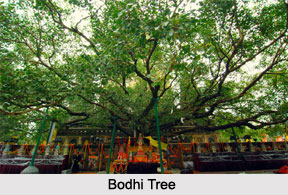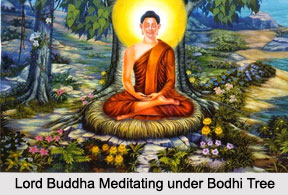 Bodhi Tree, one of the chief revered locations, is believed to be the place where Lord Buddha attained enlightenment about 2500 years ago. The tree itself is not the actual tree but a descendant of the original Bodhi Tree. The Bodhi Tree was a huge and antique variety of the Peepal tree, located at the Mahabodhi Temple at Bodh Gaya, about 100 km from Patna in the Indian state of Bihar. The tree is 80 feet high and about 115 years old. Also, there is a stone platform on which the Buddha is supposed to have sat in meditation gazing east, under the Bodhi tree. The tree is worshipped by the Hindus, Jains as well as the Buddhists. One unique feature of the tree is its large and conspicuous heart shaped leaves.
Bodhi Tree, one of the chief revered locations, is believed to be the place where Lord Buddha attained enlightenment about 2500 years ago. The tree itself is not the actual tree but a descendant of the original Bodhi Tree. The Bodhi Tree was a huge and antique variety of the Peepal tree, located at the Mahabodhi Temple at Bodh Gaya, about 100 km from Patna in the Indian state of Bihar. The tree is 80 feet high and about 115 years old. Also, there is a stone platform on which the Buddha is supposed to have sat in meditation gazing east, under the Bodhi tree. The tree is worshipped by the Hindus, Jains as well as the Buddhists. One unique feature of the tree is its large and conspicuous heart shaped leaves.
Lord Buddha"s Enlightenment under Bodhi Tree
Gautama Buddha had strictly practised asceticism for 6 years in the vicinity of the Niranjana River near Bodh Gaya. But when he realized that this asceticism was not leading to true consciousness, he stopped spending his life as an ascetic. When he came to the adjoining village of Senani, he was served milk rice by a Brahmin girl named "Sujata". Reinforced by this food, he took some kusha grass and used it as a mat to sit underneath the Peepal Tree (now called the Bodhi Tree) facing the east direction. He was resolute not to leave the place before gaining enlightenment. As he sat in profound contemplation, Maya, the Lord of Illusion, representing the illusions that lie beneath every person"s mind, continuously endeavoured to distract him from reaching his goal. Gautama then took recourse to the earth, calling it to bear testimony to the innumerable good values that led him to this place of enlightenment. The earth trembled to authenticate the genuineness of his words. Although Maya let loose his army of devils on Gautama to divert and entice him from his purpose, he conquered the inner barriers and emerged a winner by transforming the demons weapons into flowers by the power of his compassion. In the process, his mind became entirely subdued. Even after the passage of 7 days after attaining enlightenment, the Buddha continued with his meditation without getting up. For 2 weeks more, the Buddha"s contemplation went on.
Legends of Bodhi Tree
 The tree finds mention in the "Kalingabodhi Jataka", which gives a vivid narrative of the tree and the adjoining area before the enlightenment, and the "Asokavadana", which relates the story of King Ashoka"s switch to Buddhism. His consequent worship under the revered tree angered his queen so much that she ordered the tree to be cut down. Ashoka then heaped up earth around the base and poured milk on its roots. The tree astonishingly rejuvenated and grew to a height of 37 metres. He then enclosed the tree within a three-meter high stone wall for its safety. The tree is believed to be the sapling of original Bodhi tree, which was taken away by King Ashoka"s daughter to Sri Lanka. It is agreed that the actual tree died and another was planted there using its sapling taken from Sri Lanka.
The tree finds mention in the "Kalingabodhi Jataka", which gives a vivid narrative of the tree and the adjoining area before the enlightenment, and the "Asokavadana", which relates the story of King Ashoka"s switch to Buddhism. His consequent worship under the revered tree angered his queen so much that she ordered the tree to be cut down. Ashoka then heaped up earth around the base and poured milk on its roots. The tree astonishingly rejuvenated and grew to a height of 37 metres. He then enclosed the tree within a three-meter high stone wall for its safety. The tree is believed to be the sapling of original Bodhi tree, which was taken away by King Ashoka"s daughter to Sri Lanka. It is agreed that the actual tree died and another was planted there using its sapling taken from Sri Lanka.
Religious Importance of Bodhi Tree
The term "Bodhi Tree" is also commonly used for presently existing trees, particularly the sacred Fig growing at the Mahabodhi Temple, which is probably a direct progeny of the initial variety. This tree is very often visited by pilgrims, and is the most important of the four consecrated sites of the Buddhists. Other hallowed Bodhi trees, which have a great importance in the history of Buddhism, are the "Anandabodhi Tree" in Sravasti and the Bodhi Tree in Anuradhapura. While the Buddha was still alive, in order that the people might make their offerings in the name of the Buddha when he was away on pilgrimage, he certified the planting of a seed from the Bodhi Tree in Bodhgaya in front of the gateway of Jetavana Monastery near Sravasti. With this intention Moggallana took a fruit from the tree as it dropped from its stalk, before it arrived at the ground. Anathapindika placed it in a golden jar with great splendour and ceremony. A sap instantaneously sprouted forth, fifty cubits high, and in order to sanctify it the Buddha spent one night under it, rapt in contemplation. This tree, because it was planted under the supervision of Ananda, came to be recognized as the "Ananda Bodhi". The current Bodhi Tree still carry out a very significant job for Buddhists of all traditions, being a reminder and an inspiration, an emblem of peace, of Buddha"s enlightenment and of the eventual prospective that lies within us all. During the yearly celebrations of "Vaishakha", thousands of people from all over India would come to this place to smear the roots of the sanctified Bodhi Tree with fragrant water and perfumed milk, and to offer flowers and music.




















